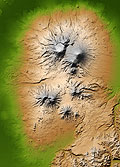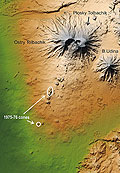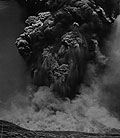1000-24
Plosky Tolbachik volcano and Tolbachik lava field
Plosky Tolbachik volcano: 55°49' N, 160°23' E, summit elevation of 3085 m
Tolbachik volcano and a lava field of the same name occupy the southwestern sector of the Kliuchevskoi volcanic group (Fig. 1). Tolbachik volcano is built by two coalesced cones: Ostry ("Sharp") Tolbachik and Plosky ("Flat") Tolbachik (Fig. 2, 5-7). Both cones were built in the main by the end of the late Pleistocene and are composed of medium-K basaltic andesite (Ermakov and Vazheevskaya, 1973).
In the beginning of the Holocene, a regional fissure zone started to form repeatedly producing high-K basaltic lavas different in composition from those of the stratovolcanoes. The zone crossed Plosky Tolbachik volcano and filled it with new high-K magma. After a series of flank eruptions, a 3-km summit caldera formed, which later was partly filled by a shield-like volcano now hidden under a glacier. A smaller caldera and a modern crater, intermittently filled by a lava lake, are located in the western part of the larger caldera (Fig. 7). Weak historical eruptions from Plosky Tolbachik produced mostly ash. Extinct Ostry Tolbachik was partly destroyed by a sector collapse ~6.5 yr BP, probably related to the formation of the larger summit caldera on the adjacent Plosky Tolbachik.
Tolbachik lava field is a product of the regional fissure zone activity and is formed by numerous cinder cones and their lava flows (Fig. 2). The zone first stretches for 40 km, from the southern tip of the field NNE towards Plosky Tolbachik volcano, then crosses the latter (Fig. 6), and extends for another 14 km to the northeast. The zone resembles rift zones on some Hawaiian volcanoes (Fedotov, 1984). Peculiar feature of the Tolbachik lava field is that its lavas belong to two different series: high-K high-Al basalts, on the one hand, and medium-K high-Mg basalts – on the other. Low-viscosity high-K basalts were erupting here during the whole Holocene while medium-K high-Mg lavas appeared only since ~1700 yr BP (Braitseva et al., 1981). A minor amount of mixed lava varieties was also reported.
Tolbachik volcano and lava field became famous in 1975-76, when Kamchatka largest historical basaltic eruption occurred here. The eruption vents were located along a ~28-km-long fissure and produced both medium-K high-Mg and high-K high-Al basalts.
The eruption started on June 28, 1975, from weak explosions from the Plosky Tolbachik summit crater. Then, on July 6, the Northern cones started to form ~18 km southwest of Plosky Tolbachik (Fig. 3). During 72 days three large cones and a number of lava flows were formed (Fig. 4). The eruption also produced ~0.7 km3 of airborne tephra, which converted an area of ~400 km2 into a lifeless desert (Fig. 5). Most of the erupted products were medium-K high-Mg basalt. During the last five days, however, the composition of the erupted rocks changed to high-K high-Al basalts with some transitional varieties. Total volume of the erupted products is estimated at ~1.18 km3 (Fedotov, 1984).
Plosky Tolbachik volcano has been producing small amounts of ash of high-K high-Al basalt during the Northern cones activity, but at the end of the latter magma was withdrawn down the summit crater and a new collapse caldera formed. Soon after this and one day after the termination of the Northern cones activity, on September 17, 1975, a new eruption started ~10 km SSW of the latter. It lasted till December 10, 1976, and was mainly effusive in character. The eruption formed a single cone (Southern Cone), a large lava field and a minor amount of tephra. The erupted products were mainly high-K high-Al basalts with some transitional varieties in the beginning of the eruption. Total volume of the products erupted from the Southern cone is estimated at ~1 km3.
Mapping and tephrochronological dating (Fig. 8) of the older cinder cones and lava flows permitted the reconstruction of the eruptive history of the Tolbachik lava field. The activity was organized in spurts, with main pulses in the early Holocene time, then ~6.9; 3.5; 2.6; 1.9-1.3 and ~1 ka BP (14C ages). All the large cinder cones (e.g., 1004, Alaid, Pelmen) were formed during the last 1700 years and are composed of medium-K high-Mg basalt. So volcanic history during these years is a history of coexistence and interaction of two different magmatic systems. The most recent active period likely started in 1740, when a large lava field Zvezda was formed (high-K high-Al basalts). Then there was an eruption in 1941 (medium-K high-Mg basalt), and in 1975-76.
Basic literature
1975-76
eruption:
Tokarev P.I. (1978) Prediction and characteristics of the 1975 eruption
of Tolbachik volcano, Kamchatka. Bull Volcanol, 41: 251-258
Fedotov S.A. and Markhinin Ye.K. (Eds) (1983) The Great Tolbachik Fissure Eruption. geological and geophysical data, 1975-1976, Cambridge Earth Sci. series: Cambridge Univ Press, 341 p.
Fedotov S.A. (Ed.) (1984) Great Tolbachik Fissure Eruption, Kamchatka, 1975?1976. Nauka, Moscow, 640 p. (In Russian)
Abramov V.A., Volynets O.N., Petrov L.L., Flerov G.B. (1979) Geochemical
model for the Great Tolbachik Fissure Eruption based on analysis of kynetics
of basaltic melts mixing. Bull Vulkanol Stancii, 55: 3-17 (In Russian)
Volynets O.N., Flerov G.B., Andreev V.N. et al. (1978) Petrochemistry,
geochemistry and origin of the rocks of the Great Tolbachik Fissure Eruption
1975-1976. Transactions of the USSR Academy of Sciences. V.238, #4, p.
940-943
Doubik P, Hill BE (1999) Magmatic and hydromagmatic conduit development
during the 1975 Tolbachik eruption, Kamchatka, with implications for
hazards assessment at Yucca Mountain, NV. J Volc Geotherm Res, 91: 43-64
Connor CB, Lichtner PC, Conway FM, Hill BE, Ovsyannikov AA, Fedorchenko
I, Doubik YuM, Shapar VN, and Taran YuA (1997) Cooling of an igneous
dike 20 yr after intrusion. Geology: Vol. 25, No. 8, pp. 711–714.
Numerous papers published mainly in Russian in the Bulletin of Volcanological
Stations (Bulletin Vulkanologicheskih Stancii), Volcanology and Seismology,
and Transactions of the USSR Academy of Sciences. Many of them are summarized
in Fedotov, 1984.
1941 eruption:
Piip B.I. 1946. New flank vent on Tolbachik volcano. Bull Vulkanol Stancii, 13: 6-10 (In Russian)
New minerals:
Filatov SK, Vergasova LP, Gorskaya MG, Krivovichev SV, Burns PC, Ananiev
VV (2001) Bradaczekite, NaCu4(AsO4)3, a new mineral species from the
Tolbachik volcano,Kamchatka Peninsula, Russia. The Canadian Mineralogist,
39: 1115-1119
Krivovichev SV, Vergasova LP, Starova GL, Filatov SK, Britvin SN, Roberts AC, and Steele IM (2002) Burnsite, KCdCu7O2(SeO3)2Cl9, a new mineral species from the Tolbachik volcano, Kamchatka Peninsula, Russia. The Canadian Mineralogist, 40 (4): 1171-1175
Vergasova LP, Krivovichev SV, Britvin SN, Burns PC, Ananiev VV (2004)
Filatovite, K[(Al, Zn)2(As, Si)2O8], a new mineral species from the Tolbachik
volcano, Kamchatka peninsula, Russia. European Journ Mineral, 16 (3):
533-536(4)
http://www.mindat.org/loc-5602.html
http://minmax.net/loc.php?id=2209&lang=en&SID=20fa95c5e80d5f3cbad614d7ae990a6d&lang=en
Plosky and Ostry Tolbachik volcanoes
Ermakov VA and Vazheevskaya AA (1973) Ostry and Plosky Tolbachik volcanoes.
Bull Vulkanol Stancii, 49: 36-43 (In Russian)
Eruptive history of the Tolbachik lava field
Braitseva O.A., Melekestsev I.V., Ponomareva V.V., Litasova S.N., and Sulerzhitsky L.D. (1981) Tephrochronological and geochronological studies of the Tolbachik regional zone of cinder cones. Volcanol Seismol, 3: 14-28 (In Russian)
Braitseva
O.A., Melekestsev I.V., Flerov G.B., Ponomareva V.V., Sulerzhitsky
L.D. and Litasova S.N. (1984) Holocene volcanism of the Tolbachik regional
zone of cinder cones. In: S.A. Fedotov (Editor) Great Tolbachik Fissure
Eruption, Kamchatka, 1975-1976. Nauka, Moscow, p. 177-209 (In Russian)







